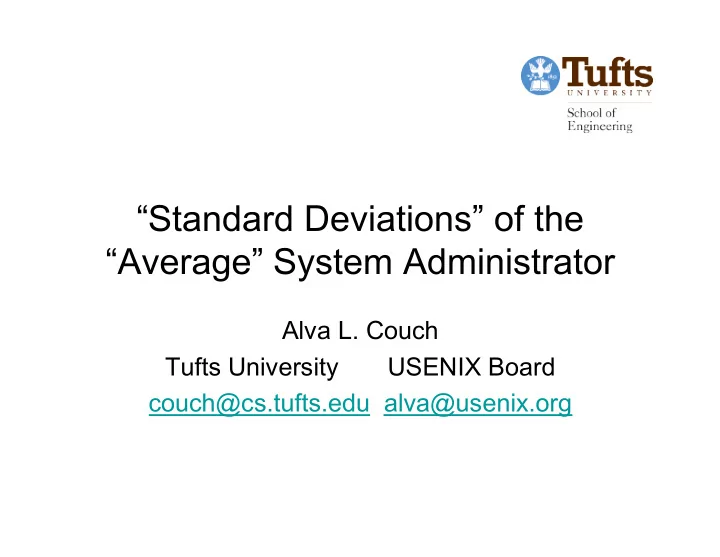

“Standard Deviations” of the “Average” System Administrator Alva L. Couch Tufts University USENIX Board couch@cs.tufts.edu alva@usenix.org
Goals of this talk • Challenge “ mores ” of the profession. • Make established sysadmins angry . • Make beginning sysadmins happier. • Ask some tough questions . • Take a controversial stance on how to improve the practice and profession.
In the last episode, • The Microsoft Certified Engineer (MSCE) exams: – Do not measure system administration capability. – Do not accept some “correct” answers. – Were not trusted by potential employers in the audience.
In this episode, • The MSCE program is fantastic! – …from a certain point of view… – …and Darth Vader isn’t Luke’s father…
Some definitions • Conformity: attempting to do things the same way as others (an ad-hoc process ). • Consistency: result of doing things the same way (an ad-hoc result ). • Standards: specific goals for conformity (a structured result ). • Compliance: obeying standards (a structured process ).
We are a culture of non-conformists • I can make my systems work better than that. • I value being creative and trying new things. • It’s more efficient for me to manage a network molded in my own image. • I don’t care if others don’t understand it. • I feel more secure if others cannot do my job. • I can’t afford to conform and also fight fires. • All of these are value judgments .
Cost of non-conformity How many of you: • can delegate any job to another administrator? • can quit and be replaced by an outsider in a reasonable time? • have documentation that describes and explains your choices? Non-conformity costs money!
Uses of System Administration Standards • Reduce need for documentation . • Reinforce best practices to management. • Exploit social footprint of software. • Promote interchangeability of staff. • Reduce learning curve for new staff.
Key to using SA standards • Adopt a global view and risk model . • Analyze lifecycle cost of decisions. • Consider the health of the profession .
MSCE Revisited • What’s the value of memorizing “ the right way ” to do something? • Answer: if everyone does it that way, you know how it was done . • The MSCE approach defines a de-facto standard. • So if you assume management of a system previously managed by an MSCE-certified admin, there’s a good chance you’ll understand what was done! • Makes no sense for the individual . • Makes a lot of sense for the organization .
Analogous to the MSCE: National Electrical Code • There are many ways an electrician could wire a house. • But there are only a small number of approved ways. • These are listed in the National Electrical Code (NEC). • (local codes provide amendments)
What the NEC does • Provides documentation of best practices. • Concentrates on externally observable and verifiable results of practice . • Supports a guild system that trains people in the code. • Defines what it means to certify results. • Compliance is required by law.
Non-technical tenets of the NEC • Wiring is forever . • If you touch it, you make it comply . • Standards are: – unambiguous, – externally verifiable , – and based upon a shared risk model .
Learning From Electricians • Can test knowledge , but not skills . • Must observe results of skills in the work environment. • This requires apprenticeship and inspection . • Goal of inspection is checking for compliance with standards .
A good system administration standard: • Codifies and documents best practices . • Utilizes global knowledge of the effects of decisions. • Informs management about vital parts of the job that they might otherwise ignore. • Reduces the need for local documentation of site practices. • Supports interchangeability of staff and site maturity . • Provides a meaningful metric with which sites can be checked for compliance .
Low-hanging fruit • Many choices we make as system administrators have nothing to do with behavior. • I have called these “incidental” choices. • Schwartzberg and Couch (2004): most of a web server’s configuration is incidental. • Examples: names of servers, mount points for file servers, locations of home directories, locations of web content, etc.
High-hanging fruit • Other standards concern quality of practice. – Electrician Example: use electrical tape to prevent shorts. – Sysadmin Example: monitor behavior of services to prevent undetected outages. • Purpose of these standards: inform management.
Downsides of Standards • Can give hackers more information about site weaknesses . • Can make networks more vulnerable by enforcing a systems monoculture . • Can mandate lower-performance solutions.
Discussion Questions • Do you think your organization has standards for system administration? • Do advantages outweigh disadvantages in adopting standards? • Should we foster health of the individual over health of the profession?
See also • My ;login: articles in August and October 2008 issues.
“Standard Deviations” of the “Average” System Administrator Alva L. Couch Tufts University USENIX Board couch@cs.tufts.edu alva@usenix.org
Recommend
More recommend